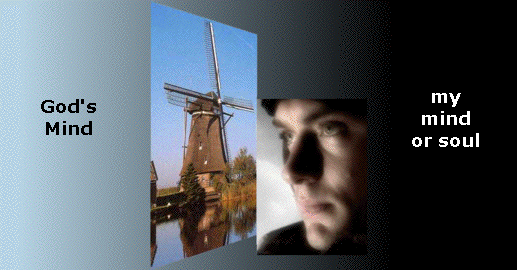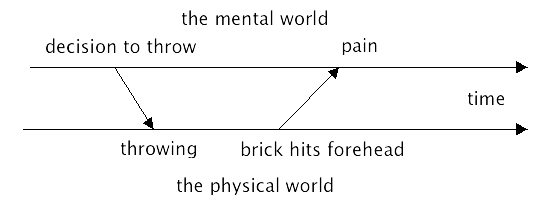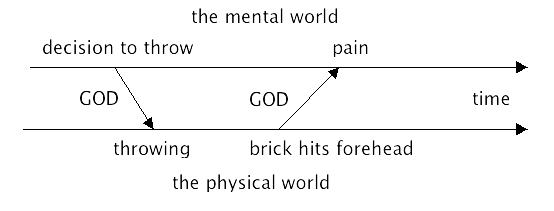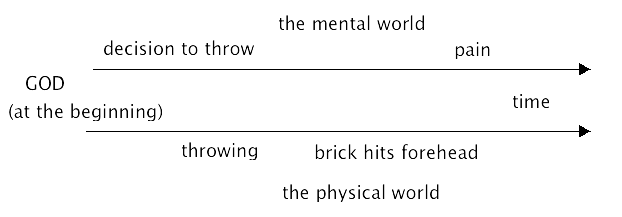
Dr. C. George Boeree

Metaphysics is that part of philosophy that examines the composition of the universe, and asks “what is the world -- including us -- made of?” “What is the ultimate substance?”
You might assume that this is more interesting to a physicist than a psychologist. Physics, in fact, gets its name from the Greek word physis, which means “ultimate substance.” But for psychology, one of the enduring problems is the relationship between the mind and the body. Is the mind, for example, just the activity of the brain, as many suppose? Or is it more than that? This is one of the issues that psychology has inherited from religion as well as philosophy: We can just as well ask about the separate existence of the soul, and its relationship to mind and body. Psyche, after all, is the Greek word for soul!
For a variety of reasons, philosophers generally would like it if
there were exactly one ultimate substance in the universe -- an idea
called monism.
Call it a love of simplicity. But the problem is, of course,
which
one? There are two major competitors for the title:
Materialism says that the universe is made entirely of
matter.
Matter, for philosophers, includes energy and anything in the physical
sense. Some early Greek philosophers, for example, thought that
the whole world (including
us) was made of water. Others thought it was fire. Others
still
thought the universe was composed of invisible particles which were
neither
created nor destroyed called atoms. Today, physicists (and
chemists,
and biologists, and most psychologists) have agreed on more complex
explanations
which, nonetheless, boil down to physical reality.

(Please note that “materialism” does not refer here to the love of material things!)
Idealism is the other competitor for the title. Idealism says that the universe is made of the spiritual or the mental, which they refer to as idea or the ideal. Early Greeks also had a variety of ideas regarding what particular brand of ideal constituted the universe. Some would say the entire world was nothing more than God’s dream (like some Hindu philosophers would argue). Others saw it as a sort of life force. Others still saw it as the perfection behind the flawed world we perceive. Modern idealist philosophers talk in terms of a world of persons, or a world of qualities.

(Again a note: “Idealism” does not here refer to living
by high
ideals!)
Although it may seem to you that materialism is the obviously better answer, that is more a matter of culture than philosophy. The majority of philosophers have been idealists, because idealism is a bit more reasonable than materialism! Consider: Have you ever seen “matter?” If you look at a chair, for example, you see its shape, its colors. If you touch it, you feel resistance, warmth or coolness. You can tap it and hear sounds, smell it or lick it (if you really want to), and so on. You experience many mental events, but never, all by its lonesome, matter! But ideas -- all you have to do is have a thought, and you experience it as self-evident!
(We’ll come back to some more kinds of monism in a bit.)
The usual alternative to monism is called -- logically enough -- dualism.
It
is simply a matter of saying that there are, in fact, two different
substances in this universe: material and ideal. For
psychology, this would be the idea that the mind (or spirit) and the
body are both equally real, and that neither can be reduced to the
other.

Now, this sounds like the obvious solution to the dilemma. But there is a serious philosophical problem: If there are two different substances in the universe, how could they possibly interact? How does the soul, which is presumed to be without mass or extension, cause the body to act? And how do the things that happen to the body somehow change from physical activities into a mental thing?
Think about it for a minute. It is easy to say that, when we see a red apple, the light waves cause chemical reactions in the retina, which cause sensory neurons to fire, which causes neurotransmitters to sail across synapses, which send the neural signals deeper and deeper into the brain, the activity of which is the thing we call “seeing the red apple.” But no matter how much detail you provide, at no point do you convert all this physical activity into the experience of an apple!
Likewise, if I have a thought that says “I’m going to throw the apple at you,” there’s no question that there will be neural activity, translated into muscular activity, translated into the flight of the apple. But when, where, and how did that thought become a neural activity? Some refer to this problem as the mind-body problem. Others call it the ghost in the machine.
Descartes, in addition to be the father of modern philosophy, also took time out to promote the idea of the reflex. In his day, hydraulic devices were all the rage -- fountains with moving characters. Descartes simply suggested that living creatures are similar mechanisms (no different than we do today when we suggest that the brain is just a wet computer.)
But Descartes was also a devout Catholic who believed we had an
immortal soul. How that soul influenced the body or the body the
soul remained a mystery. Descartes thought that perhaps the
pineal gland (a few inches behind your eyes) was a conduit that let in
the “animal spirits” from our souls, which traveled through the nerves
and made our muscles move. A bad guess.

Descartes’ type of dualism is called interactionism:
There are two substances, they interact, I don’t know how. That,
of course, is less than satisfactory. So other philosophers put
in their two cents. A French priest named Nicholas Malebranche
suggested that God
intervenes, and makes us experience things when stuff happens to our
bodies, and makes our bodies move when we will it.
Since these interactions occur in all of us every day, a million times
a
day, God must be very busy. But God is, well, God... so it is
clearly
a possibility. This type of dualism is called occasionalism.

Another explanation was given by the German genius Leibniz. He
suggested that, rather than have God intercede a gazillion times a day,
He could have simply set the entire universe going in two coordinated
paths, one material, one spiritual. Like I can set two clocks --
one an antique pendulum clock and one an electric digital -- to keep
the same time, even though they are completely different mechanisms and
have no contact with each other, so
God could have done the same with the body and the mind. This is
called
parallelism. Again, not a bad explanation.

But philosophers (and psychologists) desire more certain knowledge
than faith. So the search for an answer went on. Perhaps
the most
impressive of the enlightenment answers came from the lens-grinder
Benedict
Spinoza. His theory is called double-aspectism. It
is
a monism that looks like a dualism: The mind and the body, he
said,
are two sides of one “coin,” which is the true ultimate substance of
the
universe.

So, if a brick hits you on the forehead, the physical things happening inside your head have another side to them, which is the pain you experience. And the thought you have to raise your hand to touch the bruise has another side to it, which is the physical act of doing so. Problem solved!
But perhaps not quite. If you say that the entire universe has two sides to it, you have to include not only mind and brain. Spinoza believed that God is what we call the mental side of the universe, and nature is what we call the physical side. God is the mind of nature, and nature is God’s body! This is called pantheism. In Spinoza’s day, it was called atheism, and was grounds in most countries for a bonfire, with you as the guest of honor.
Even if you kind of like the idea of pantheism, keep in mind that it also implies panpsychism -- everything has to have its mental side. So animals and plants have souls and rocks have thoughts (albeit slow and simple ones!). On the other hand, there can be no soul in heaven that is not attached to some body. These ideas are a little harder to take.
Much later, William James, “the father of American psychology,” and
our best philosopher in his spare time, came up with neutral monism.
He
suggested that Spinoza was nearly right, but not quite. The
physical is the one ultimate substance as seen from one perspective,
and the mental or spiritual is that substance seen from another
perspective. The
ultimate substance is something else, something neutral. This
means
that it is quite alright to say that some things can only be seen as
physical,
others only as mental, and some as both.

The problem that remains is the question we started out with: What then is the ultimate substance? One recent suggestion is information. This doesn't stray too far from materialism and is popular with the artificial intelligence movement and cognitivists in psychology. Another suggestion is more idealist, and offers quality as the ultimate substance, quality sometimes having physical characteristics, sometimes mental ones.
William James also came up with another idea called pluralism. Strictly speaking, of course, dualism is a pluralism. But he suggested that the were many more than two “ultimate substances.” There is matter, of course, and mind. But there is also math and logic -- are they physical or are they mental, or are they something else? And there’s space and time -- what are they? Even the material can be divided into matter, energy, gravity, and so on. And the mental includes thoughts, perceptions, imagery, feelings, will, choice, etc. Some of these things may interact (matter and energy, for example, via E = mc²). Others may not interact with anything else. The problem? Now instead of having two ultimate substances we need to reconcile, we have hundreds.
Perhaps the most popular metaphysics among researchers in psychology is called epiphenomenalism. This approach suggests that, while materialism is clearly the way to go in the sciences, it is also undeniable that there is something real about our inner, psychological life. So, say the epiphenomenalists, let's allow that there is something called mind which we have yet to pin down, but let's also say that the mind is nothing more than a by-product of brain! Sort of like heat is a by-product of an engine's operation: If we could design a perfect engine, all energy would translate into motion instead of heat! So, if we completely understood the brain, we would no longer need the concept mind. This is just a form of materialism, although a more humble form.
So the problem remains. “How does all this relate to ordinary psychology?” you might ask. Well, think about anything having to do with psychology -- love, anger, perception, mental illness, psychopharmacology.... What is depression? Is it a perceptual or emotional problem? Or is it a matter of serotonin availability? Should we use drugs to alter people with problems such as these, or is it a matter of helping them to change their perspectives on life? If it’s a combination of the two, how do we know how much of the problem is one or the other? Is it the same for everyone? The mind-body problem does indeed remain, right at the very heart of psychology.
© Copyright 1999, C. George Boeree. All rights reserved.